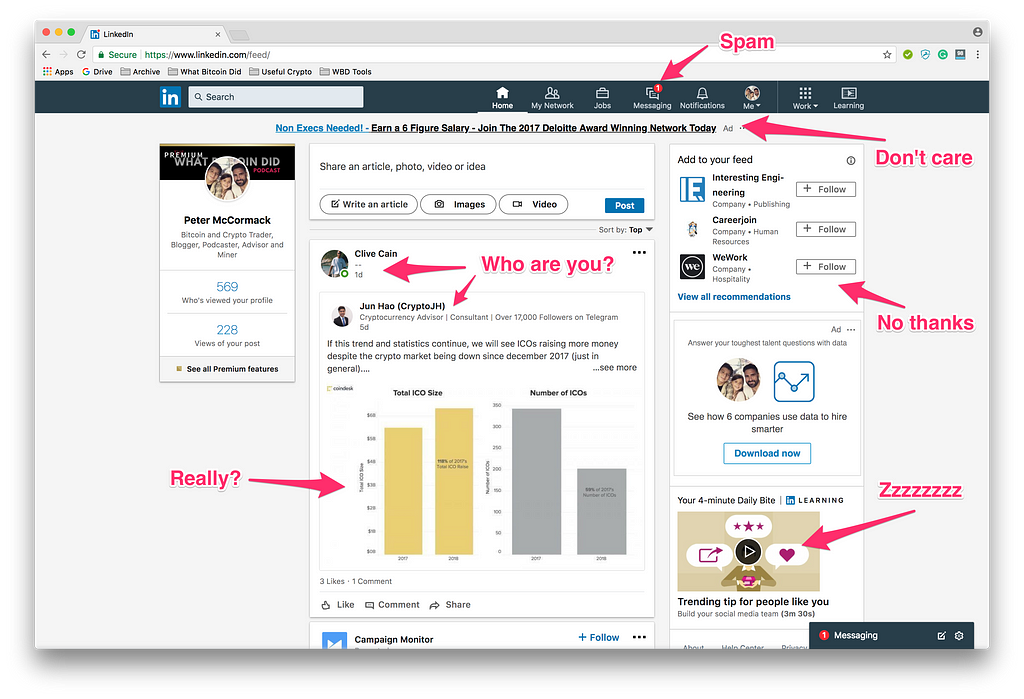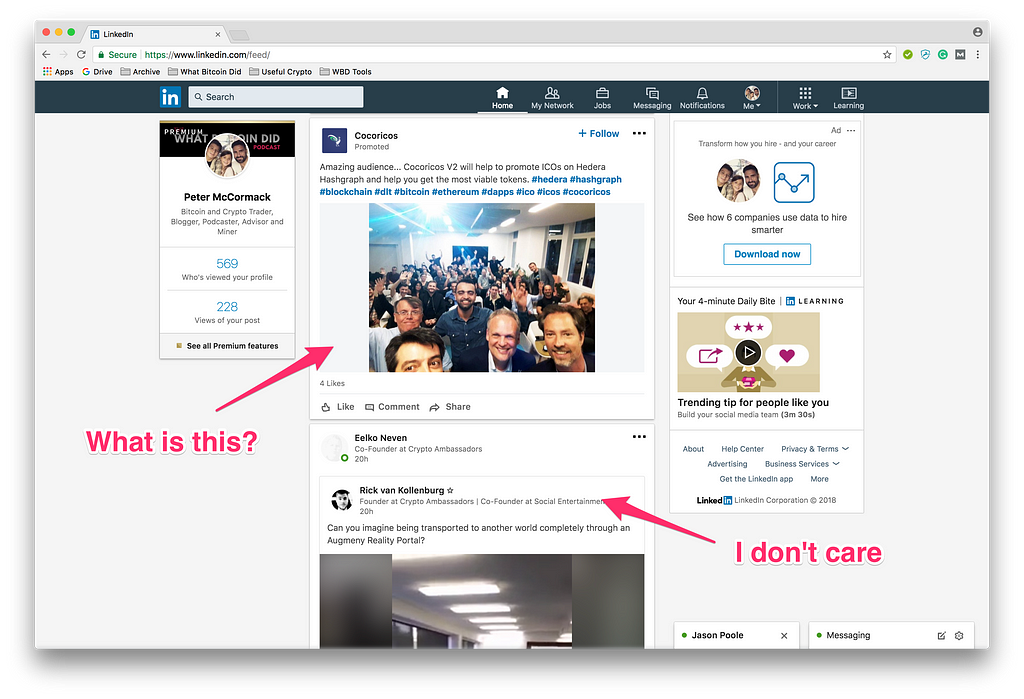Latest news about Bitcoin and all cryptocurrencies. Your daily crypto news habit.

Full transparency: I am an investor in SpringRole, a decentralised professional network, a competitor of LinkedIn. This article is about why I have invested in the platform.
LinkedIn: A World of Spam and People I Don’t Know
Email Ping: <Random Unknown Person> wants to connect with you. Yay, another person I don’t know who wants to connect with me. Another person who wants to ask me if I am interested in their crappy ICO or if I know someone who will buy a VERY LARGE amount of Bitcoin over the counter.
This is all I appear to do on LinkedIn, login, accept a request, read spam, and then block the user. You see, the novelty of checking who has viewed my profile has worn thin and the only real interest I have in the newsfeed is to push my content, sorry, but I don’t care about yours.
Indeed LinkedIn has become almost entirely pointless, a selfish social network.
The funny thing is that Twitter is now a better professional network than LinkedIn:
- My content reaches more people who are interested in it
- I find more content than I am interested in
- I make real contacts which I care about, talk to and have even become friends with
The other great thing about Twitter is that I am entertained by memes and engaging debates (with the odd dramatic argument thrown in the mix), which means I want to come back to it. LinkedIn, sorry, I don’t care that some random person I don’t know has a new job or that old colleague’s PowerPoint presentation listing 10 Ways to Optimise Your Website.
Outside of using InMail to book interviews, LinkedIn is almost entirely pointless.
LinkedIn: The Confused Social Network!
LinkedIn appears to be experiencing a severe existential crisis:
- Is it a platform for professional networking?
- Is it a social networking platform like Facebook & Twitter?
- Or is it a media company whose primary monetisation model is ads?
Who knows? They appear to have taken and butchered the features of other social networks in an attempt to make them work for the business community. But they don’t.
Does the platform want to serve value to businesses, or to working professionals? What is the actual purpose of LinkedIn?
To answer this, let’s look at a few problems that the network faces today.
I won’t waste too long on the UI design, though LinkedIn, please note the investment in design by Google and Facebook, this shit is important! You look like you have used a free Wordpress skin from 10 years ago.
Perhaps the biggest problem with LinkedIn is the newsfeed, obviously inspired by other social networks <cough>Facebook</cough>, they have made it the core feature on everyone’s experience on LinkedIn. It is obvious why? Repeat visits and page views, for those pesky ads.
But for a newsfeed to work, it has also to have engaging content for us to suffer the self-serving crap, something Facebook is wrestling with now: if you want your baby pictures, then you also have to see some news and ads. The trade-off for a free platform is that we have to make a few people on the Sand Hill road rich.
The problem with the LinkedIn newsfeed is that it only has self-serving business content, which only the hardcore dedicated LinkedIn user suffers because they hardcore care about networking. The same people who get up at 5am once a week to go and eat a crappy scrambled egg at a business network meeting at their local golf club.
The problem with the newsfeed is compounded by who I am connected with, because my 2,500 contacts are made up of:
- A small handful of friends
- A slightly larger handful of people I used to work with and don’t care about anymore
- Several handfuls of people I have accepted requests from but don’t know or care about in the slightest
While LinkedIn advertises itself as a professional network, it just as often described as a having a ‘social’ function it clearly lacks. While users can create and share content, the people who take the time to do this are often those with a vested interest in doing so — for example, marketers and PR professionals. Unfortunately, most members say very little, assuming they are even active on the platform. Hence, LinkedIn is social, but in a very antisocial way.
So my newsfeed is just a bunch of content, I don’t care about from people I don’t know or care about.
And some ads, lol! I can imagine how poorly they perform.
Another problem that Linkedin has not been able to solve is authenticity. Any information that is put up by a user and any claim made by them is questionable. There is no verification process in place to make sure that user profiles are genuine and authentic.
One of the simplest things to fake is getting endorsed. The problem with this is that Linkedin counts anything as a skill, just as long as the registered user has added it. To make matters worse, anyone in their network can endorse them for a skill they claim to possess.
So, are endorsements a useful way to assess connections? Or are they a bogus way for people to ingratiate themselves with one another? I have people I don’t know, authenticating skills they can’t know I have.
Shall we lol again?
And then the reviews, which really is “Hey, leave me an amazing review telling everyone how amazing I am and I’ll do the same for you buddy.” So my LinkedIn profile now says I am pretty much amazing at everything digital, I am the Einstein of Digital Marketing who is without flaw. Except I am, I am crap at account management, often late to meetings and massively disorganised. To counter that, I think I am pretty good at strategy and can cut through the bullshit. My clients trust my judgement but not my delivery, which is why I always employed others to do that bit.
Isn’t that more useful? Right, Pete is good at strategy, cool we need a strategy but he will be late for our meeting and can’t account manage, okay, we’ll make sure he assigns a decent account director to us.
And this is the root of the problem. LinkedIn has to keep everyone happy to keep them on the platform. Therefore everyone has to look great. It would be like Yelp only having 5* reviews for every restaurant.
Wouldn’t it be more useful to everyone if it was honest:“Sorry, but little Johnny was crap, and we had to let him go, he was always late to work, lazy and spent all day on YouTube.”
Employers would know that little Johnny is a waste of time and little Johnny would grasp that he has to get his shit together. Then guess what, if little Johnny doesn’t get his shit together then tough, life will come at him pretty fast, but if he does, LinkedIn will show what excellent progress he has made, and he learns from his mistakes.
LinkedIn: Gotta Make Some Money
For a long time, LinkedIn’s principal source of revenue came from the company subscription model, in which companies paid LinkedIn a fee to access professional profiles and connect with them for potential hiring. As the ecosystem grew, LinkedIn faced stiff competition from Facebook and Google, who made money much faster through advertising. LinkedIn eventually succumbed to the pressure and introduced ads. This resulted in diluting the whole purpose of LinkedIn.
I have written before about why online advertising doesn’t work, you can read it on LinkedIn, rofl!
Privacy is another major concern today. The platform offers a range of privacy options, but the poor design makes navigating through the settings complicated. Discovering which settings work to restrict fraudulent accounts from accessing user information is an uphill task, on a platform I don’t care about.
Most importantly, the job ecosystem on LinkedIn is entirely flawed. When the skills that users claim might be questionable, skill mapping to the jobs ecosystem loses all purpose. It ends up being a money-making model in which companies post jobs and users search for those jobs. For the process to work effectively, both the users and the companies must pay a subscription fee to Linkedin.
The Solution: <Hint>Where I Have Invested</Hint>
Now before you jump down my throat and say, of course, I am recommending this solution as I have invested in it. Let’s get our chickens and eggs in the right order. I invested in SpringRole because they solve a problem.
Modern day technologies provide us with opportunities that can help in overcoming the inherent flaws of LinkedIn. A Blockchain, for example, can help bring accountability to such a platform. Any information that a user claims can be verified and attested, is written on the blockchain where it is immutable (this means it can’t be changed). The users can control all of their data and decide to share it with whom they like to. All user skills can be completely attested, and hence, the platform becomes a genuine one — the jobs ecosystem can then make logical sense.
In the crypto world, using tokens in the right way can bring in accountability to a platform. For example, SpringRole is working on using tokens and building a trust-based professional network, in which every user is accountable for what they claim. On the platform, every user will be rewarded with tokens for tasks that they perform. That way, when one has to spend real tokens to attest or verify a claim, those claims will end up being more genuine.
Blockchain and its applications are going to change a lot of industries as we know them today. Perhaps it is time that the Internet world moves towards a more genuine and trustworthy ecosystem.
I am putting my money where my big mouth is!
The Pointless World of LinkedIn was originally published in Hacker Noon on Medium, where people are continuing the conversation by highlighting and responding to this story.
Disclaimer
The views and opinions expressed in this article are solely those of the authors and do not reflect the views of Bitcoin Insider. Every investment and trading move involves risk - this is especially true for cryptocurrencies given their volatility. We strongly advise our readers to conduct their own research when making a decision.
